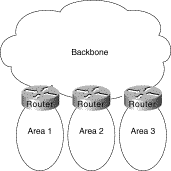
OSPF Internetwork Design Guidelines
BGP Internetwork Design Guidelines
This chapter focuses on the following design implications of the Enhanced Interior Gateway Routing Protocol (IGRP), Open Shortest Path First (OSPF) protocols, and the Border Gateway Protocol (BGP):
Enhanced IGRP, OSPF, and BGP are routing protocols for the Internet Protocol (IP). An introductory discussion outlines general routing protocol issues; subsequent discussions focus on design guidelines for the specific IP protocols.
The following discussion provides an overview of the key decisions you must make when selecting and deploying routing protocols. This discussion lays the foundation for subsequent discussions regarding specific routing protocols.
The physical topology of an internetwork is described by the complete set of routers and the networks that connect them. Networks also have a logical topology. Different routing protocols establish the logical topology in different ways.
Some routing protocols do not use a logical hierarchy. Such protocols use addressing to segregate specific areas or domains within a given internetworking environment and to establish a logical topology. For such nonhierarchical, or flat, protocols, no manual topology creation is required.
Other protocols require the creation of an explicit hierarchical topology through establishment of a backbone and logical areas. The OSPF and Intermediate System-to-Intermediate System (IS-IS) protocols are examples of routing protocols that use a hierarchical structure. A general hierarchical network scheme is illustrated in Figure 3-1. The explicit topology in a hierarchical scheme takes precedence over the topology created through addressing.
Figure 3-1: Hierarchical
network.

If a hierarchical routing protocol is used, the addressing topology should be assigned to reflect the hierarchy. If a flat routing protocol is used, the addressing implicitly creates the topology. There are two recommended ways to assign addresses in a hierarchical network. The simplest way is to give each area (including the backbone) a unique network address. An alternative is to assign address ranges to each area.
Areas are logical collections of contiguous networks and hosts. Areas also include all the routers having interfaces on any one of the included networks. Each area runs a separate copy of the basic routing algorithm. Therefore, each area has its own topological database.
Figure 3-2 illustrates an example of route summarization. In this environment, Router R2 maintains one route for all destination networks beginning with B, and Router R4 maintains one route for all destination networks beginning with A. This is the essence of route summarization. Router R1 tracks all routes because it exists on the boundary between A and B.
Figure 3-2: Route summarization
example.
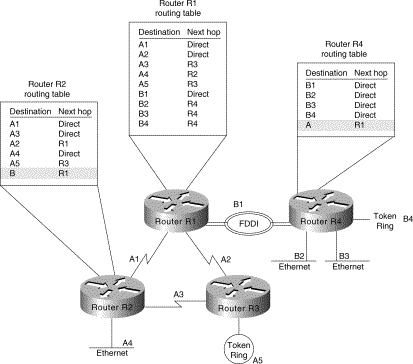
The reduction in route propagation and routing information overhead can be significant. Figure 3-3 illustrates the potential savings. The vertical axis of Figure 3-3 shows the number of routing table entries. The horizontal axis measures the number of subnets. Without summarization, each router in a network with 1,000 subnets must contain 1,000 routes. With summarization, the picture changes considerably. If you assume a Class B network with eight bits of subnet address space, each router needs to know all of the routes for each subnet in its network number (250 routes, assuming that 1,000 subnets fall into four major networks of 250 routers each) plus one route for each of the other networks (three) for a total of 253 routes. This represents a nearly 75-percent reduction in the size of the routing table.
The preceding example shows the simplest type of route summarization: collapsing all the subnet routes into a single network route. Some routing protocols also support route summarization at any bit boundary (rather than just at major network number boundaries) in a network address. A routing protocol can summarize on a bit boundary only if it supports variable-length subnet masks (VLSMs).
Some routing protocols summarize automatically. Other routing protocols require manual configuration to support route summarization, as shown in Figure 3-3.
Figure 3-3: Route summarization
benefits.
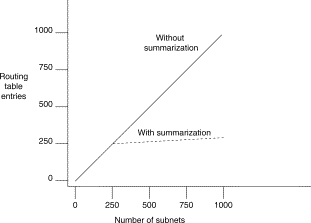
Route selection is trivial when only a single path to the destination exists. However, if any part of that path should fail, there is no way to recover. Therefore, most networks are designed with multiple paths so there are alternatives in case a failure occurs.
Routing protocols compare route metrics to select the best route from a group of possible routes. Route metrics are computed by assigning a characteristic or set of characteristics to each physical network. The metric for the route is an aggregation of the characteristics of each physical network in the route. Figure 3-4 shows a typical meshed network with metrics assigned to each link and the best route from source to destination identified.
Figure 3-4: Routing metrics and route
selection.

Routing protocols use different techniques for assigning metrics to individual networks. Further, each routing protocol forms a metric aggregation in a different way. Most routing protocols can use multiple paths if the paths have an equal cost. Some routing protocols can even use multiple paths when paths have an unequal cost. In either case, load balancing can improve overall allocation of network bandwidth.
When multiple paths are used, there are several ways to distribute the packets. The two most common mechanisms are per-packet load balancing and per-destination load balancing. Per-packet load balancing distributes the packets across the possible routes in a manner proportional to the route metrics. With equal-cost routes, this is equivalent to a round-robin scheme. One packet or destination (depending on switching mode) is distributed to each possible path. Per-destination load balancing distributes packets across the possible routes based on destination. Each new destination is assigned the next available route. This technique tends to preserve packet order.
When fast switching is enabled on a router (default condition), route selection is done on a per- destination basis. When fast switching is disabled, route selection is done on a per-packet basis. For line speeds of 56 Kbps and faster, fast switching is recommended.
When network topology changes, network traffic must reroute quickly. The phrase "convergence time" describes the time it takes a router to start using a new route after a topology changes. Routers must do three things after a topology changes:
Some changes are immediately detectable. For example, serial line failures that involve carrier loss are immediately detectable by a router. Other failures are harder to detect. For example, if a serial line becomes unreliable but the carrier is not lost, the unreliable link is not immediately detectable. In addition, some media (Ethernet, for example) do not provide physical indications such as carrier loss. When a router is reset, other routers do not detect this immediately. In general, failure detection is dependent on the media involved and the routing protocol used.
Once a failure has been detected, the routing protocol must select a new route. The mechanisms used to do this are protocol-dependent. All routing protocols must propagate the changed route. The mechanisms used to do this are also protocol-dependent.
The capability to extend your internetwork is determined, in part, by the scaling characteristics of the routing protocols used and the quality of the network design.
Network scalability is limited by two factors: operational issues and technical issues. Typically, operational issues are more significant than technical issues. Operational scaling concerns encourage the use of large areas or protocols that do not require hierarchical structures. When hierarchical protocols are required, technical scaling concerns promote the use of small areas. Finding the right balance is the art of network design.
From a technical standpoint, routing protocols scale well if their resource use grows less than linearly with the growth of the network. Three critical resources are used by routing protocols: memory, central processing unit (CPU), and bandwidth.
Routing protocols use memory to store routing tables and topology information. Route summarization cuts memory consumption for all routing protocols. Keeping areas small reduces the memory consumption for hierarchical routing protocols.
CPU usage is protocol-dependent. Some protocols use CPU cycles to compare new routes to existing routes. Other protocols use CPU cycles to regenerate routing tables after a topology change. In most cases, the latter technique will use more CPU cycles than the former. For link-state protocols, keeping areas small and using summarization reduces CPU requirements by reducing the effect of a topology change and by decreasing the number of routes that must be recomputed after a topology change.
Bandwidth usage is also protocol-dependent. Three key issues determine the amount of bandwidth a routing protocol consumes:
When the network is stable, link-state protocols minimize bandwidth usage by sending updates only when a change occurs. A hello mechanism ascertains reachability of neighbors. When a failure occurs in the network, link-state protocols flood link-state advertisements (LSAs) throughout an area. LSAs cause every router within the failed area to recalculate routes. The fact that LSAs need to be flooded throughout the area in failure mode and the fact that all routers recalculate routing tables constrain the number of neighbors that can be in an area.
In WANs, consideration of bandwidth is especially critical. For example, Frame Relay, which statistically multiplexes many logical data connections (virtual circuits) over a single physical link, allows the creation of networks that share bandwidth. Public Frame Relay networks use bandwidth sharing at all levels within the network. That is, bandwidth sharing may occur within the Frame Relay network of Corporation X, as well as between the networks of Corporation X and Corporation Y.
Two factors have a substantial effect on the design of public Frame Relay networks:
Overall, WANs can lose packets because of lack of bandwidth. For Frame Relay networks, this possibility is compounded because Frame Relay does not have a broadcast replication facility, so for every broadcast packet that is sent out a Frame Relay interface, the router must replicate it for each PVC on the interface. This requirement limits the number of PVCs that a router can handle effectively.
In addition to bandwidth, network designers must consider the size of routing tables that need to be propagated. Clearly, the design considerations for an interface with 50 neighbors and 100 routes to propagate are very different from the considerations for an interface with 50 neighbors and 10,000 routes to propagate. Table 3-1 gives a rough estimate of the number of WAN neighbors that a routing protocol can handle effectively.
Table 3-1: Routing Protocols and Number
of WAN Neighbors
| Routing Protocol | Number of Neighbors per Router |
|---|---|
| Distance vector | 50 |
| Link state | 30 |
| Advanced distance vector | 30 |
Controlling access to network resources is a primary concern. Some routing protocols provide techniques that can be used as part of a security strategy. With some routing protocols, you can insert a filter on the routes being advertised so that certain routes are not advertised in some parts of the network.
Some routing protocols can authenticate routers that run the same protocol. Authentication mechanisms are protocol specific and generally weak. In spite of this, it is worthwhile to take advantage of the techniques that exist. Authentication can increase network stability by preventing unauthorized routers or hosts from participating in the routing protocol, whether those devices are attempting to participate accidentally or deliberately.
OSPF is an Interior Gateway Protocol (IGP) developed for use in Internet Protocol (IP)-based internetworks. As an IGP, OSPF distributes routing information between routers belonging to a single autonomous system (AS). An AS is a group of routers exchanging routing information via a common routing protocol. The OSPF protocol is based on shortest-path-first, or link-state, technology.
The OSPF protocol was developed by the OSPF working group of the Internet Engineering Task Force (IETF). It was designed expressly for the Internet Protocol (IP) environment, including explicit support for IP subnetting and the tagging of externally derived routing information. OSPF Version 2 is documented in Request for Comments (RFC) 1247.
Whether you are building an OSPF internetwork from the ground up or converting your internetwork to OSPF, the following design guidelines provide a foundation from which you can construct a reliable, scalable OSPF-based environment.
Two design activities are critically important to a successful OSPF implementation:
Ensuring that these activities are properly planned and executed will make all the difference in your OSPF implementation. Each is addressed in more detail with the discussions that follow. These discussions are divided into nine sections:
OSPF works best in a hierarchical routing environment. The first and most important decision when designing an OSPF network is to determine which routers and links are to be included in the backbone and which are to be included in each area. There are several important guidelines to consider when designing an OSPF topology:
The discussions that follow address topology issues that are specifically related to the backbone and the areas.
OSPF backbones must be contiguous. All routers in the backbone should be directly connected to other backbone routers. OSPF includes the concept of virtual links. A virtual link creates a path between two area border routers (an area border router is a router connects an area to the backbone) that are not directly connected. A virtual link can be used to heal a partitioned backbone. However, it is not a good idea to design an OSPF network to require the use of virtual links. The stability of a virtual link is determined by the stability of the underlying area. This dependency can make troubleshooting more difficult. In addition, virtual links cannot run across stub areas. See the section "Backbone-to-Area Route Advertisement" later in this chapter for a detailed discussion of stub areas.
Avoid placing hosts (such as workstations, file servers, or other shared resources) in the backbone area. Keeping hosts out of the backbone area simplifies internetwork expansion and creates a more stable environment.
Individual areas must be contiguous. In this context, a contiguous area is one in which a continuous path can be traced from any router in an area to any other router in the same area. This does not mean that all routers must share common network media. It is not possible to use virtual links to connect a partitioned area. Ideally, areas should be richly connected internally to prevent partitioning. The two most critical aspects of area design follow:
Areas should have a contiguous set of network and/or subnet addresses. Without a contiguous address space, it is not possible to implement route summarization. The routers that connect an area to the backbone are called area border routers. Areas can have a single area border router or they can have multiple area border routers. In general, it is desirable to have more than one area border router per area to minimize the chance of the area becoming disconnected from the backbone.
When creating large-scale OSPF internetworks, the definition of areas and assignment of resources within areas must be done with a pragmatic view of your internetwork. The following are general rules that help ensure that your internetwork remains flexible and provides the kind of performance needed to deliver reliable resource access:
Address assignment and route summarization are inextricably linked when designing OSPF internetworks. To create a scalable OSPF internetwork, you should implement route summarization. To create an environment capable of supporting route summarization, you must implement an effective hierarchical addressing scheme. The addressing structure that you implement can have a profound impact on the performance and scalability of your OSPF internetwork. The following sections discuss OSPF route summarization and three addressing options:
Route summarization is extremely desirable for a reliable and scalable OSPF internetwork. The effectiveness of route summarization, and your OSPF implementation in general, hinges on the addressing scheme that you adopt. Summarization in an OSPF internetwork occurs between each area and the backbone area. Summarization must be configured manually in OSPF. When planning your OSPF internetwork, consider the following issues:
One of the simplest ways to allocate addresses in OSPF is to assign a separate network number for each area. With this scheme, you create a backbone and multiple areas, and assign a separate IP network number to each area. Figure 3-11 illustrates this kind of area allocation.
Figure 3-11: Assignment of NIC
addresses example.
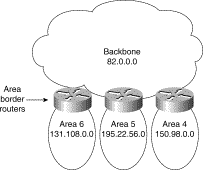
The following are the basic steps for creating such a network:
Step 1 Define your structure (identify areas and allocate nodes to areas).
Step 2 Assign addresses to networks, subnets, and end stations.
In the network illustrated in Figure 3-11, each area has its own unique NIC-assigned address. These can be Class A (the backbone in Figure 3-11), Class B (areas 4 and 6), or Class C (Area 5). The following are some clear benefits of assigning separate address structures to each area:
In the example illustrated in Figure 3-11, the route summarization configuration at the area border routers is greatly simplified. Routes from Area 4 injecting into the backbone can be summarized as follows: All routes starting with 150.98 are found in Area 4.
The main drawback of this approach to address assignment is that it wastes address space. If you decide to adopt this approach, be sure that area border routers are configured to do route summarization. Summarization must be explicitly set; it is disabled by default in OSPF.
Bit-wise subnetting and variable-length subnetwork masks (VLSMs) can be used in combination to save address space. Consider a hypothetical network where a Class B address is subdivided using an area mask and distributed among 16 areas. The Class B network, 156.77.0.0, might be sub- divided as illustrated in Figure 3-12.
Figure 3-12: Areas and subnet
masking.
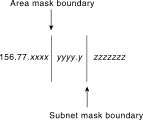
In Figure 3-12, the letters x, y, and z represent bits of the last two octets of the Class B network as follows:
Private addressing is another option often cited as simpler than developing an area scheme using bit-wise subnetting. Although private address schemes provide an excellent level of flexibility and do not limit the growth of your OSPF internetwork, they have certain disadvantages. For instance, developing a large-scale internetwork of privately addressed IP nodes limits total access to the Internet, and mandates the implementation of what is referred to as a demilitarized zone (DMZ). If you need to connect to the Internet, Figure 3-13 illustrates the way in which a DMZ provides a buffer of valid NIC nodes between a privately addressed network and the Internet.
All nodes (end systems and routers) on the network in the DMZ must have NIC-assigned IP addresses. The NIC might, for example, assign a single Class C network number to you. The DMZ shown in Figure 3-13 has two routers and a single application gateway host (Garp). Router A provides the interface between the DMZ and the Internet, and Router B provides the firewall between the DMZ and the private address environment. All applications that need to run over the Internet must access the Internet through the application gateway.
Figure 3-13: Connecting to the Internet
from a privately addressed network.
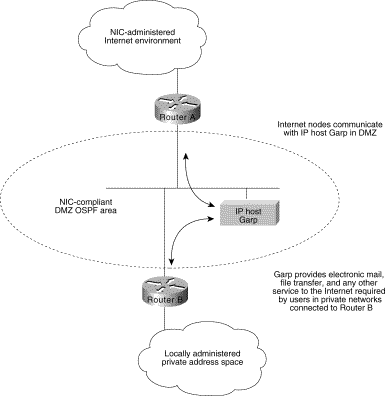
Route summarization is particularly important in an OSPF environment because it increases the stability of the network. If route summarization is being used, routes within an area that change do not need to be changed in the backbone or in other areas. Route summarization addresses two important questions of route information distribution:
There are several key considerations when setting up your OSPF areas for proper summarization:
There are four potential types of routing information in an area:
In general, it is desirable to restrict routing information in any area to the minimal set that the area needs. There are three types of areas, and they are defined in accordance with the routing information that is used in them:
Table 3-2 shows the different types of areas according to the routing information that they use.
Routing Information Used in OSPF Areas
| Area Type | Default Route |
Intra-area Routes | Interarea Routes |
External Routes |
|---|---|---|---|---|
| Nonstub | Yes | Yes | Yes | Yes |
| Stub | Yes | Yes | Yes | No |
| Stub without summaries | Yes | Yes | No | No |
Stub areas are configured using the area
area-id stub router configuration command. Routes
are summarized using the area
area-id range address
mask router configuration command. Refer to your Router
Products Configuration Guide and Router Products Command
Reference publications for more information regarding the use of these
commands.
When designing an OSPF internetwork for efficient route selection, consider three important topics:
The default value for OSPF metrics is based on bandwidth. The following characteristics show how OSPF metrics are generated:
When an area has only a single area border router, all traffic that does not belong in the area will be sent to the area border router. In areas that have multiple area border routers, two choices are available for traffic that needs to leave the area:
If the area border routers inject only the default route, the traffic goes to the area border router that is closest to the source of the traffic. Generally, this behavior is desirable because the backbone typically has higher bandwidth lines available. However, if you want the traffic to use the area border router that is nearest the destination (so that traffic leaves the area as late as possible), the area border routers should inject summaries into the area instead of just injecting the default route.
Most network designers prefer to avoid asymmetric routing (that is, using a different path for packets that are going from A to B than for those packets that are going from B to A). It is important to understand how routing occurs between areas to avoid asymmetric routing.
Internetwork topologies are typically designed to provide redundant routes in order to prevent a partitioned network. Redundancy is also useful to provide additional bandwidth for high traffic areas. If equal-cost paths between nodes exist, Cisco routers automatically load balance in an OSPF environment.
Cisco routers can use up to four equal-cost paths for a given destination. Packets might be distributed either on a per-destination (when fast switching) or a per-packet basis. Per-destination load balancing is the default behavior. Per-packet load balancing can be enabled by turning off fast switching using the no ip route-cache interface configuration command. For line speeds of 56 Kbps and faster, it is recommended that you enable fast switching.
One of the most attractive features about OSPF is the capability to quickly adapt to topology changes. There are two components to routing convergence:
Your ability to scale an OSPF internetwork depends on your overall network structure and addressing scheme. As outlined in the preceding discussions concerning network topology and route summarization, adopting a hierarchical addressing environment and a structured address assignment will be the most important factors in determining the scalability of your internetwork. Network scalability is affected by operational and technical considerations:
An OSPF router stores all of the link states for all of the areas that it is in. In addition, it can store summaries and externals. Careful use of summarization and stub areas can reduce memory use substantially.
An OSPF router uses CPU cycles whenever a link-state change occurs. Keeping areas small and using summarization dramatically reduces CPU use and creates a more stable environment for OSPF.
OSPF sends partial updates when a link-state change occurs. The updates are flooded to all routers in the area. In a quiet network, OSPF is a quiet protocol. In a network with substantial topology changes, OSPF minimizes the amount of bandwidth used.
Two kinds of security are applicable to routing protocols:
Prior to NSSA, to disable an area from receiving external (Type 5) link-state advertisements (LSAs), the area needed to be defined as a stub area. Area Border Routers (ABRs) that connect stub areas do not flood any external routes they receive into the stub areas. To return packets to destinations outside of the stub area, a default route through the ABR is used.
RFC 1587 defines a hybrid area called the Not-So-Stubby Area (NSSA). An OSPF NSSA is similar to an OSPF stub area but allows for the following capabilities:
Use OSPF NSSA in the following scenarios:
In Figure 3-14, the central site and branch office are interconnected through a slow WAN link. The branch office is not using OSPF, but the central site is. Rather than define an RIP domain to connect the sites, you can define an NSSA.
Figure 3-14: OSPF NSSA
operation.
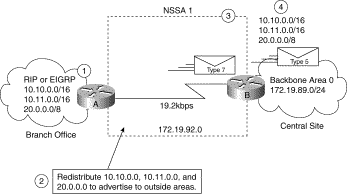
In this scenario, Router A is defined as an ASBR (autonomous system border router). It is configured to redistribute any routes within the RIP/EIGRP domain to the NSSA. The following lists what happens when the area between the connecting routers is defined as an NSSA:
2. Because Router A is also connected to an NSSA, it redistributes the RIP or EIGRP routers as Type 7 LSAs into the NSSA.
3. Router B, an ABR between the NSSA and the backbone Area 0, receives the Type 7 LSAs.
4. After the SPF calculation on the forwarding database, Router B translates the Type 7 LSAs into Type 5 LSAs and then floods them throughout Backbone Area 0. It is at this point that router B could have summarized routes 10.10.0.0/16 and 10.11.0.0/16 as 10.0.0.0/8, or could have filtered one or more of the routes.
Type 7 LSAs have the following characteristics:
The steps used to configure OSPF NSSA are as follows:
Step 1 Configure standard OSPF operation on one or more interfaces that will be attached to NSSAs.
Step 2 Configure an area as NSSA using the following commands:
router(config)#area area-id nssa
Step 3 (Optional) Control the summarization or filtering during the translation. Figure 3-15 shows how Router will summarize routes using the following command:
router(config)#summary-address prefix mask [not-advertise] [tag tag]
Figure 3-15: Configuring OSPF
NSSA.
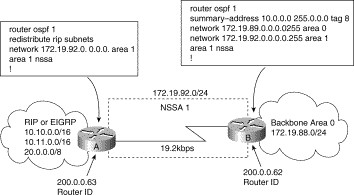
Be sure to evaluate these considerations before implementing NSSA. As shown in Figure 3-15, you can set a Type 7 default route that can be used to reach external destinations. The command to issue a Type 7 default route is as follows:
router(config)#area area-id nssa [default-information-originate]
When configured, the router generates a Type 7 default into the NSSA by the NSSA ABR. Every router within the same area must agree that the area is NSSA; otherwise, the routers will not be able to communicate with one another.
If possible, avoid doing explicit redistribution on NSSA ABR because you could get confused about which packets are being translated by which router.
Prior to this feature, OSPF periodic Hello and link-state advertisement (LSA) updates would be exchanged between routers that connected the on-demand link even when there were no changes in the Hello or LSA information.
With OSPF On Demand Circuit, periodic Hellos are suppressed and periodic refreshes of LSAs are not flooded over demand circuits. These packets bring up the links only when they are exchanged for the first time, or when there is a change in the information they contain. This operation allows the underlying data link layer to be closed when the network topology is stable, thus keeping the cost of the demand circuit to a minimum.
This feature is a standards-based mechanism that is similar to the Cisco Snapshot feature used for distance vector protocols such as RIP.
This feature is useful when you want to have an OSPF backbone at the central site and you want to connect telecommuters or branch offices to the central site. In this case, OSPF On Demand Circuit allows the benefits of OSPF over the entire domain without excessive connection costs. Periodic refreshes of Hello updates and LSA updates and other protocol overhead are prevented from enabling the on-demand circuit when there is no "real" data to transmit.
Overhead protocols such as Hellos and LSAs are transferred over the on-demand circuit only upon initial setup and when they reflect a change in the topology. This means that topology-critical changes that require new shortest path first (SPF) calculations are transmitted in order to maintain network topology integrity, but periodic refreshes that do not include changes are not transmitted across the link.
Figure 3-16 illustrates general OSPF operation over on-demand circuits.
Figure 3-16: OSPF area.

The following steps describe the procedure shown in Figure 3-16:
2. When Router A receives refreshed LSAs for existing entries in its database, it will determine whether the LSAs include changed information. If not, Router A will update the existing LSA entries, but it will not flood the information to Router B. Therefore, both routers will have the same entries, but the entry sequence numbers may not be identical.
3. When Router A does receive an LSA for a new route or an LSA that includes changed information, it will update its LSA database, bring up the on-demand circuit, and flood the information to Router B. At this point, both routers will have identical sequence numbers for this LSA entry.
4. If there is no data to transfer while the link is up for the updates, the link is terminated.
5. When a host on either side needs to transfer data to another host at the remote site, the link will be brought up.
Evaluate the following considerations before implementing OSPF On Demand Circuit:
2. To take advantage of the on-demand circuit functionality within a stub area or NSSA, every router in the area must have this feature loaded. If this feature is deployed within a regular area, all other regular areas must also support this feature before the demand circuit functionality can take effect. This is because external LSAs are flooded throughout all areas.
3. Do not enable this feature on a broadcast-based network topology because Hellos cannot be successfully suppressed, which means the link will remain up.
NBMA networks are those networks that support many (more than two) routers, but have no broadcast capability. Neighboring routers are maintained on these nets using OSPF's Hello Protocol. However, due to the lack of broadcast capability, some configuration information may be necessary to aid in the discovery of neighbors. On non-broadcast networks, OSPF protocol packets that are normally multicast need to be sent to each neighboring router, in turn. An X.25 Public Data Network (PDN) is an example of a non-broadcast network. Note the following:
On non-broadcast networks in which not all routers can communicate directly, you can break the non-broadcast network into logical subnets, with the routers on each subnet being able to communicate directly. Then each separate subnet can be run as an NBMA network or a point-to-point network if each virtual circuit is defined as a separate logical subnet. This setup, however, requires quite a bit of administrative overhead, and is prone to misconfiguration. It is probably better to run such a non-broadcast network in Point-to-MultiPoint mode.
Point-to-MultiPoint networks have been designed to work simply and naturally when faced with partial mesh connectivity. In Point-to-MultiPoint mode, OSPF treats all router-to-router connections over the non-broadcast network as if they were point-to-point links. No Designated Router is elected for the network, nor is there an LSA generated for the network. It may be necessary to configure the set of neighbors that are directly reachable over the Point-to-MultiPoint network. Each neighbor is identified by its IP address on the Point-to-MultiPoint network. Because no Designated Routers are elected on Point-to-MultiPoint networks, the Designated Router eligibility of configured neighbors is undefined.
Alternatively, neighbors on Point-to-MultiPoint networks may be dynamically discovered by lower-level protocols such as Inverse ARP. In contrast to NBMA networks, Point-to-MultiPoint networks have the following properties:
2. When originating a router-LSA, Point-to-MultiPoint interface is reported as a collection of "point-to-point links" to all of the interface's adjacent neighbors, together with a single stub link advertising the interface's IP address with a cost of 0.
3. When flooding out a non-broadcast interface (when either in NBMA or Point-to- MultiPoint mode) the Link State Update or Link State Acknowledgment packet must be replicated in order to be sent to each of the interface's neighbors.
The Border Gateway Protocol (BGP) is an interautonomous system routing protocol. The primary function of a BGP speaking system is to exchange network reachability information with other BGP systems. This network reachability information includes information on the list of Autonomous Systems (ASs) that reachability information traverses. BGP-4 provides a new set of mechanisms for supporting classless interdomain routing. These mechanisms include support for advertising an IP prefix and eliminate the concept of network class within BGP. BGP-4 also introduces mechanisms that allow aggregation of routes, including aggregation of AS paths. These changes provide support for the proposed supernetting scheme. This section describes how BGP works and it can be used to participate in routing with other networks that run BGP. The following topics are covered:
This section presents fundamental information about BGP, including the following topics:
Routers that belong to the same AS and exchange BGP updates are said to be running internal BGP (IBGP). Routers that belong to different ASs and exchange BGP updates are said to be running external BGP (EBGP).
With the exception of the neighbor ebgp-multihop router configuration command (described in the section "External BGP (EBGP)" later in this chapter), the commands for configuring EBGP and IBGP are the same. This chapter uses the terms EBGP and IBGP as a reminder that, for any particular context, routing updates are being exchanged between ASs (EBGP) or within an AS (IBGP). Figure 3-17 shows a network that demonstrates the difference between EBGP and IBGP.
Figure 3-17: EBGP, IBGP, and multiple
ASs.
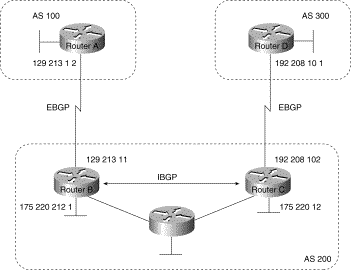
BGP uses the Transmission Control Protocol (TCP) as its transport protocol (specifically, port 179). Any two routers that have opened a TCP connection to each other for the purpose of exchanging routing information are known as peers or neighbors. In Figure 3-17, Routers A and B are BGP peers, as are Routers B and C, and Routers C and D. The routing information consists of a series of AS numbers that describe the full path to the destination network. BGP uses this information to construct a loop-free map of ASs. Note that within an AS, BGP peers do not have to be directly connected.
BGP peers initially exchange their full BGP routing tables. Thereafter, BGP peers send incremental updates only. BGP peers also exchange keepalive messages (to ensure that the connection is up) and notification messages (in response to errors or special conditions).
All BGP speakers within an AS must establish a peer relationship with one another. That is, the BGP speakers within an AS must be fully meshed logically. BGP-4 provides two techniques that alleviate the requirement for a logical full mesh: confederations and route reflectors. For information about these techniques, see the sections "Confederations" and "Route Reflectors" later in this chapter.
AS 200 is a transit AS for AS 100 and AS 300. That is, AS 200 is used to transfer packets between AS 100 and AS 300.
Internal BGP (IBGP) is the form of BGP that exchanges BGP updates within an AS. Instead of IBGP, the routes learned via EBGP could be redistributed into IGP within the AS and then redistributed again into another AS. However, IBGP is more flexible, more scalable, and provides more efficient ways of controlling the exchange of information within the AS. It also presents a consistent view of the AS to external neighbors. For example, IBGP provides ways to control the exit point from an AS. Figure 3-18 shows a topology that demonstrates IBGP.
Figure 3-18: Internal BGP
example.
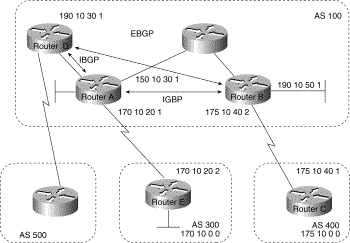
When a BGP speaker receives an update from other BGP speakers in its own AS (that is, via IBGP), the receiving BGP speaker uses EBGP to forward the update to external BGP speakers only. This behavior of IBGP is why it is necessary for BGP speakers within an AS to be fully meshed.
For example, in Figure 3-18, if there were no IBGP session between Routers B and D, Router A would send updates from Router B to Router E but not to Router D. If you want Router D to receive updates from Router B, Router B must be configured so that Router D is a BGP peer.
Loopback Interfaces. Loopback interfaces are often used by IBGP peers. The advantage of using loopback interfaces is that they eliminate a dependency that would otherwise occur when you use the IP address of a physical interface to configure BGP. Figure 3-19 shows a network in which using the loopback interface is advantageous.
Figure 3-19: Use of loopback
interfaces.
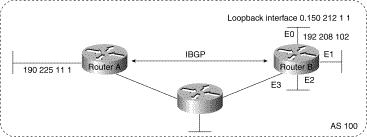
In Figure 3-19, Routers A and B are running IBGP within AS 100. If Router A were to specify the IP address of Ethernet interface 0, 1, 2, or 3 in the neighbor remote-as router configuration command, and if the specified interface were to become unavailable, Router A would not be able to establish a TCP connection with Router B. Instead, Router A specifies the IP address of the loopback interface that Router B defines. When the loopback interface is used, BGP does not have to rely on the availability of a particular interface for making TCP connections.
When two BGP speakers that are not in the same AS run BGP to exchange routing information, they are said to be running EBGP.
When an AS provides transit service to other ASs when there are non-BGP routers in the AS, transit traffic might be dropped if the intermediate non-BGP routers have not learned routes for that traffic via an IGP. The BGP synchronization rule states that if an AS provides transit service to another AS, BGP should not advertise a route until all of the routers within the AS have learned about the route via an IGP. The topology shown in Figure 3-20 demonstrates this synchronization rule.
Figure 3-20: EBGP synchronization
rule.
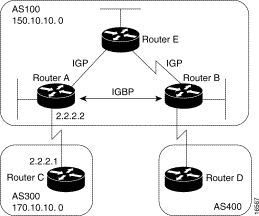
In Figure 3-20, Router C sends updates about network 170.10.0.0 to Router A. Routers A and B are running IBGP, so Router B receives updates about network 170.10.0.0 via IBGP. If Router B wants to reach network 170.10.0.0, it sends traffic to Router E. If Router A does not redistribute network 170.10.0.0 into an IGP, Router E has no way of knowing that network 170.10.0.0 exists and will drop the packets.
If Router B advertises to AS 400 that it can reach 170.10.0.0 before Router E learns about the network via IGP, traffic coming from Router D to Router B with a destination of 170.10.0.0 will flow to Router E and be dropped.
This situation is handled by the synchronization rule of BGP. It states that if an AS (such as AS 100 in Figure 3-20) passes traffic from one AS to another AS, BGP does not advertise a route before all routers within the AS (in this case, AS 100) have learned about the route via an IGP. In this case, Router B waits to hear about network 170.10.0.0 via an IGP before it sends an update to Router D.
In some cases, you might want to disable synchronization. Disabling synchronization allows BGP to converge more quickly, but it might result in dropped transit packets. You can disable synchronization if one of the following conditions is true:
Whenever an update passes through an AS, BGP prepends its AS number to the update. The AS_path attribute is the list of AS numbers that an update has traversed in order to reach a destination. An AS-SET is a mathematical set of all the ASs that have been traversed. Consider the network shown in Figure 3-24.
Figure 3-24: AS_path
attribute.
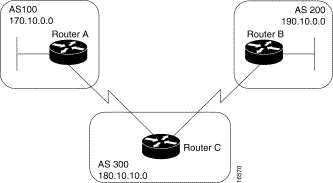
The origin attribute provides information about the origin of the route. The origin of a route can be one of three values:
Figure 3-25 shows a network that demonstrates the value of the origin attribute.
Figure 3-25: Origin
attribute.
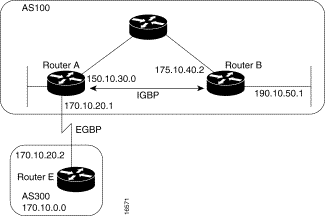
The BGP next hop attribute is the IP address of the next hop that is going to be used to reach a certain destination. For EBGP, the next hop is usually the IP address of the neighbor specified by the neighbor remote-as router configuration command. (The exception is when the next hop is on a multiaccess media, in which case, the next hop could be the IP address of the router in the same subnet.) Consider the network shown in Figure 3-26.
Figure 3-26: Next hop
attribute.

In Figure 3-26, Router C advertises network 170.10.0.0 to Router A with a next hop attribute of 170.10.20.2, and Router A advertises network 150.10.0.0 to Router C with a next hop attribute of 170.10.20.1.
BGP specifies that the next hop of EBGP-learned routes should be carried without modification into IBGP. Because of that rule, Router A advertises 170.10.0.0 to its IBGP peer (Router B) with a next hop attribute of 170.10.20.2. As a result, according to Router B, the next hop to reach 170.10.0.0 is 170.10.20.2, instead of 150.10.30.1. For that reason, the configuration must ensure that Router B can reach 170.10.20.2 via an IGP. Otherwise, Router B will drop packets destined for 170.10.0.0 because the next hop address is inaccessible.
For example, if Router B runs IGRP, Router A should run IGRP on network 170.10.0.0. You might want to make IGRP passive on the link to Router C so that only BGP updates are exchanged.
BGP might set the value of the next hop attribute differently on multiaccess media, such as Ethernet. Consider the network shown in Figure 3-27.
Figure 3-27: Multiaccess media
network.
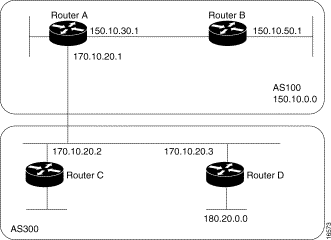
In Figure 3-27, Routers C and D in AS 300 are running OSPF. Router C is running BGP with Router A. Router C can reach network 180.20.0.0 via 170.10.20.3. When Router C sends a BGP update to Router A regarding 180.20.0.0, it sets the next hop attribute to 170.10.20.3, instead of its own IP address (170.10.20.2). This is because Routers A, B, and C are in the same subnet, and it makes more sense for Router A to use Router D as the next hop rather than taking an extra hop via Router C.
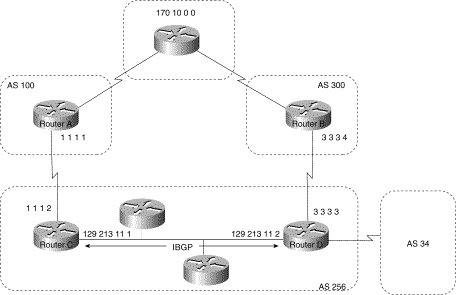
In Figure 3-30, AS 256 receives route updates for network 170.10.0.0 from AS 100 and AS 300. There are two ways to set local preference:
The multi-exit discriminator (MED) attribute is a hint to external neighbors about the preferred path into an AS when there are multiple entry points into the AS. A lower MED value is preferred over a higher MED value. The default value of the MED attribute is 0.
Unlike local preference, the MED attribute is exchanged between ASs, but a MED attribute that comes into an AS does not leave the AS. When an update enters the AS with a certain MED value, that value is used for decision making within the AS. When BGP sends that update to another AS, the MED is reset to 0.
Unless otherwise specified, the router compares MED attributes for paths from external neighbors that are in the same AS. If you want MED attributes from neighbors in other ASs to be compared, you must configure the bgp always-compare-med command. The network shown in Figure 3-31 demonstrates the use of the MED attribute.
Figure 3-31: MED example.
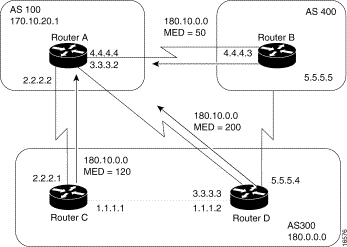
In Figure 3-31, AS 100 receives updates regarding network 180.10.0.0 from Routers B, C, and D. Routers C and D are in AS 300, and Router B is in AS 400.
The community attribute provides a way of grouping destinations (called communities) to which routing decisions (such as acceptance, preference, and redistribution) can be applied. Route maps are used to set the community attribute. A few predefined communities are listed in Table 3-3.
Table 3-2: Predefined
Communities
| Community | Meaning |
| no-export | Do not advertise this route to EBGP peers. |
| no-advertised | Do not advertise this route to any peer. |
| internet | Advertise this route to the Internet community; all routers in the network belong to it. |
BGP selects only one path as the best path. When the path is selected, BGP puts the selected path in its routing table and propagates the path to its neighbors. BGP uses the following criteria, in the order presented, to select a path for a destination:
2. Prefer the path with the largest weight.
3. If the weights are the same, prefer the path with the largest local preference.
4. If the local preferences are the same, prefer the path that was originated by BGP running on this router.
5. If no route was originated, prefer the route that has the shortest AS_path.
6. If all paths have the same AS_path length, prefer the path with the lowest origin type (where IGP is lower than EGP, and EGP is lower than Incomplete).
7. If the origin codes are the same, prefer the path with the lowest MED attribute.
8. If the paths have the same MED, prefer the external path over the internal path.
9. If the paths are still the same, prefer the path through the closest IGP neighbor.
10. Prefer the path with the lowest IP address, as specified by the BGP router ID.
This section describes how to understand and define BGP Policies to control the flow of BGP updates. The techniques include the following:
Normally, a route could be learned via more than one protocol. Administrative distance is used to discriminate between routes learned from more than one protocol. The route with the lowest administrative distance is installed in the IP routing table. By default, BGP uses the administrative distances shown in Table 3-3.
Table 3-3: BGP Administrative
Distances
| Distance | Default Value | Function |
| External | 20 | Applied to routes learned from EBGP |
| Internal | 200 | Applied to routes learned from IBGP |
| Local | 200 | Applied to routes originated by the router |
Note Distance does not influence the
BGP path selection algorithm, but
it does influence whether BGP-learned routes are installed in the IP routing
table.
A BGP peer group is a group of BGP neighbors that share the same update policies. Update policies are usually set by route maps, distribution lists, and filter lists. Instead of defining the same policies for each individual neighbor, you define a peer group name and assign policies to the peer group.
Members of a peer group inherit all of the configuration options of the peer group. Peer group members can also be configured to override configuration options if the options do not affect outgoing updates. That is, you can override options that are set only for incoming updates. The use of BGP peer groups is demonstrated by the network shown in Figure 3-36
Figure 3-36: BGP peer
groups.
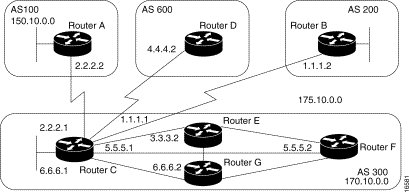
BGP4 supports classless interdomain routing (CIDR). CIDR is a new way of looking at IP addresses that eliminates the concept of classes (Class A, Class B, and so on). For example, network 192.213.0.0, which is an illegal Class C network number, is a legal supernet when it is represented in CIDR notation as 192.213.0.0/16. The /16 indicates that the subnet mask consists of 16 bits (counting from the left). Therefore, 192.213.0.0/16 is similar to 192.213.0.0 255.255.0.0.
CIDR makes it easy to aggregate routes. Aggregation is the process of combining several different routes in such a way that a single route can be advertised, which minimizes the size of routing tables. Consider the network shown in Figure 3-37.
A confederation is a technique for reducing the IBGP mesh inside the AS. Consider the network shown in Figure 3-38.
Figure 3-38: Example of
confederations.
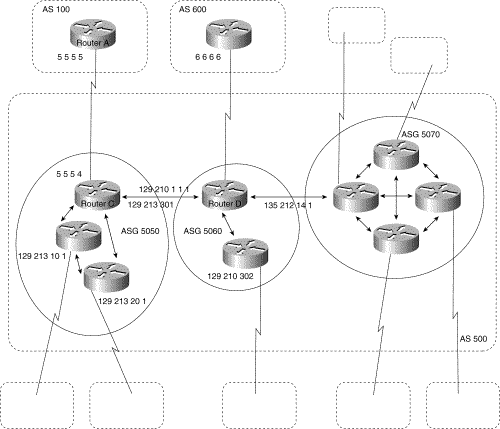
In Figure 3-38, AS 500 consists of nine BGP speakers (although there might be other routers that are not configured for BGP). Without confederations, BGP would require that the routers in AS 500 be fully meshed. That is, each router would need to run IBGP with each of the other eight routers, and each router would need to connect to an external AS and run EBGP, for a total of nine peers for each router.
Confederations reduce the number of peers within the AS, as shown in Figure 3-38. You use confederations to divide the AS into multiple mini-ASs and assign the mini-ASs to a confederation. Each mini-AS is fully meshed, and IBGP is run among its members. Each mini-AS has a connection to the other mini-ASs within the confederation. Even though the mini-ASs have EBGP peers to ASs within the confederation, they exchange routing updates as if they were using IBGP. That is, the next hop, MED, and local preference information is preserved. To the outside world, the confederation looks like a single AS.
Route reflectors are another solution for the explosion of IBGP peering within an AS. As described earlier in the section "Synchronization," a BGP speaker does not advertise a route learned from another IBGP speaker to a third IBGP speaker. Route reflectors ease this limitation and allow a router to advertise (reflect) IBGP-learned routes to other IBGP speakers, thereby reducing the number of IBGP peers within an AS. The network shown in Figure 3-39 demonstrates how route reflectors work.
Without a route reflector, the network would require a full IBGP mesh (that
is, Router A would have to be a peer of Router B). If Router C is configured
as a route reflector, IBGP peering between Routers A and B is not required
because Router C will reflect updates from Router A to Router B and from
Router B to Router A. When considered as a whole, the route reflector and
its clients are called a cluster. Other IBGP peers
of the route reflector that are not clients are called nonclients.
An AS can have more than one route reflector. When an AS has more than one route reflector, each route reflector treats other route reflectors as normal IBGP speakers. There can be more than one route reflector in a cluster, and there can be more than one cluster in an AS.
Route flap dampening (introduced in Cisco IOS Release 11.0) is a mechanism for minimizing the instability caused by route flapping. The following terms are used to describe route flap dampening:
A route that is flapping receives a penalty of 1000 for each flap. When the accumulated penalty reaches a configurable limit, BGP suppresses advertisement of the route even if the route is up. The accumulated penalty is decremented by the half-life time. When the accumulated penalty is less than the reuse limit, the route is advertised again (if it is still up).